Audi a3 8p AUDI A8 2003 D3 / 2.G Technical Features Manual
[x] Cancel search | Manufacturer: AUDI, Model Year: 2003, Model line: A8, Model: AUDI A8 2003 D3 / 2.GPages: 96, PDF Size: 5.51 MB
Page 67 of 96
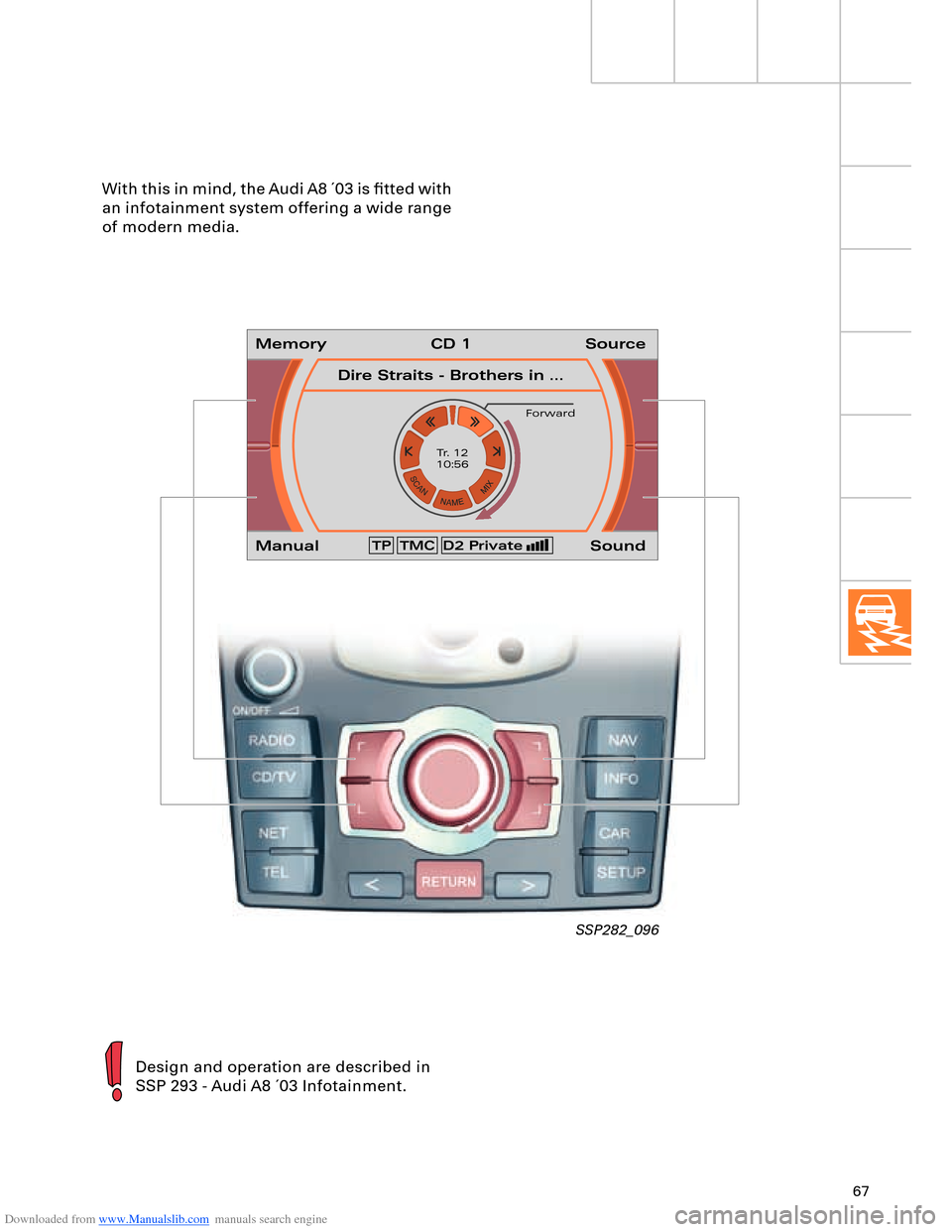
Downloaded from www.Manualslib.com manuals search engine 67
SSP282_096
TP TMC
Tr. 12
10:56
D2 Private
With this in mind, the Audi A8 ´03 is fitted with
an infotainment system offering a wide range
of modern media.
Design and operation are described in
SSP 293 - Audi A8 ´03 Infotainment.
Memory SourceCD 1
Manual SoundDire Straits - Brothers in …
Forward
Page 68 of 96
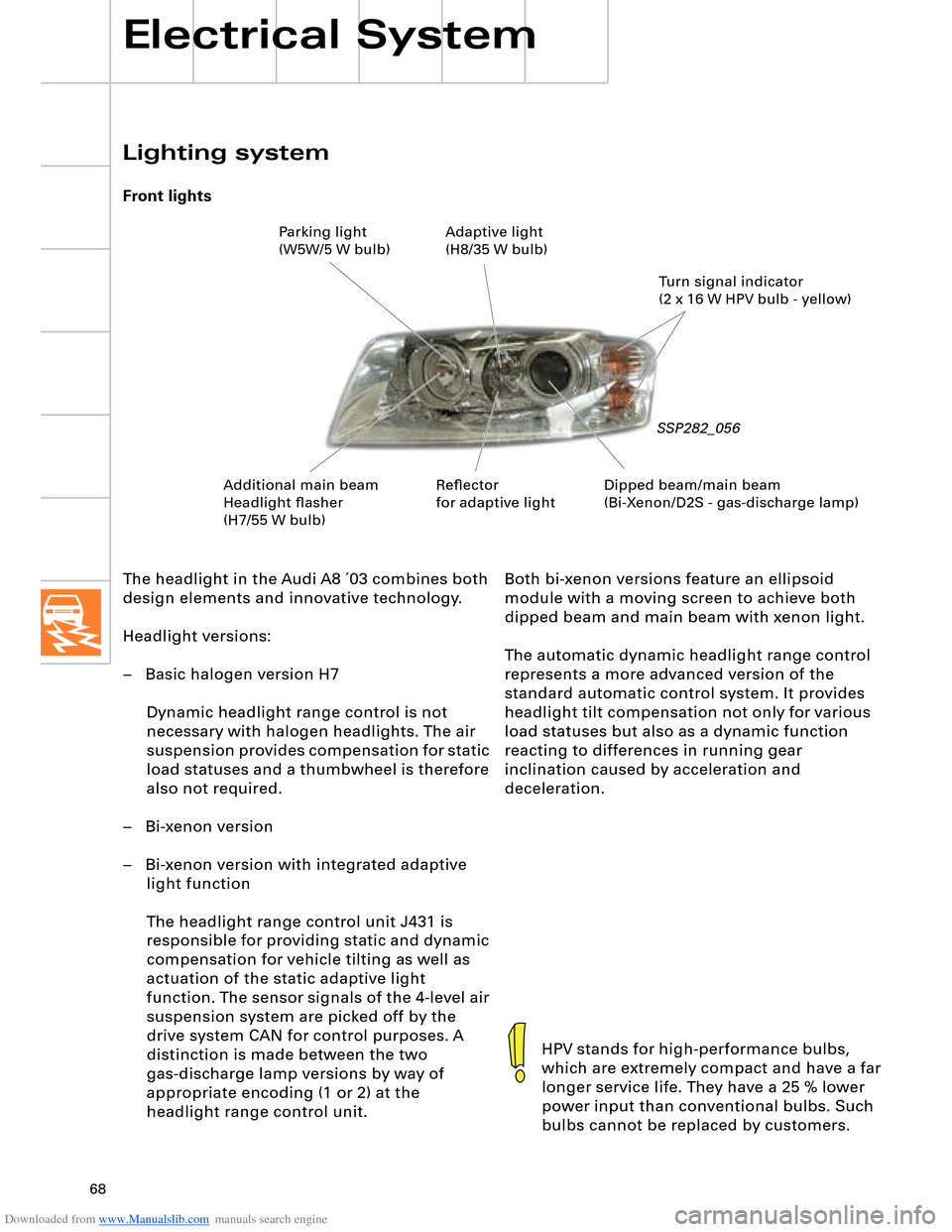
Downloaded from www.Manualslib.com manuals search engine 68
Electrical System
The headlight in the Audi A8 ´03 combines both
design elements and innovative technology.
Headlight versions:
– Basic halogen version H7
Dynamic headlight range control is not
necessary with halogen headlights. The air
suspension provides compensation for static
load statuses and a thumbwheel is therefore
also not required.
– Bi-xenon version
– Bi-xenon version with integrated adaptive
light function
The headlight range control unit J431 is
responsible for providing static and dynamic
compensation for vehicle tilting as well as
actuation of the static adaptive light
function. The sensor signals of the 4-level air
suspension system are picked off by the
drive system CAN for control purposes. A
distinction is made between the two
gas-discharge lamp versions by way of
appropriate encoding (1 or 2) at the
headlight range control unit.
Lighting system
Front lights
SSP282_056
HPV stands for high-performance bulbs,
which are extremely compact and have a far
longer service life. They have a 25 % lower
power input than conventional bulbs. Such
bulbs cannot be replaced by customers.
Both bi-xenon versions feature an ellipsoid
module with a moving screen to achieve both
dipped beam and main beam with xenon light.
The automatic dynamic headlight range control
represents a more advanced version of the
standard automatic control system. It provides
headlight tilt compensation not only for various
load statuses but also as a dynamic function
reacting to differences in running gear
inclination caused by acceleration and
deceleration.
Dipped beam/main beam
(Bi-Xenon/D2S - gas-discharge lamp)Turn signal indicator
(2 x 16 W HPV bulb - yellow) Parking light
(W5W/5 W bulb)Adaptive light
(H8/35 W bulb)
Additional main beam
Headlight flasher
(H7/55 W bulb)Reflector
for adaptive light
Page 69 of 96
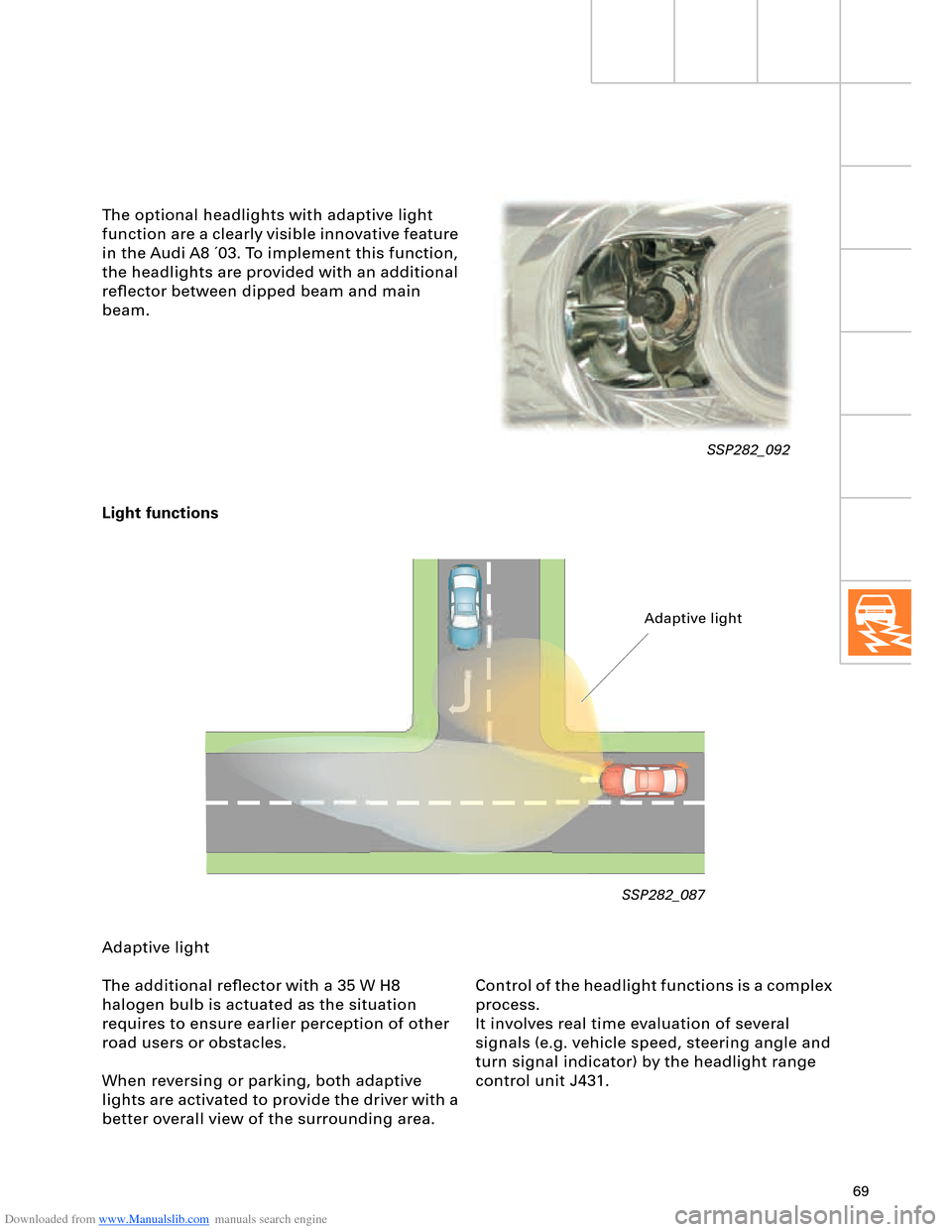
Downloaded from www.Manualslib.com manuals search engine 69
Light functions
SSP282_087
Adaptive light
The additional reflector with a 35 W H8
halogen bulb is actuated as the situation
requires to ensure earlier perception of other
road users or obstacles.
When reversing or parking, both adaptive
lights are activated to provide the driver with a
better overall view of the surrounding area.
Adaptive light
Control of the headlight functions is a complex
process.
It involves real time evaluation of several
signals (e.g. vehicle speed, steering angle and
turn signal indicator) by the headlight range
control unit J431.
SSP282_092
The optional headlights with adaptive light
function are a clearly visible innovative feature
in the Audi A8 ´03. To implement this function,
the headlights are provided with an additional
reflector between dipped beam and main
beam.
Page 70 of 96
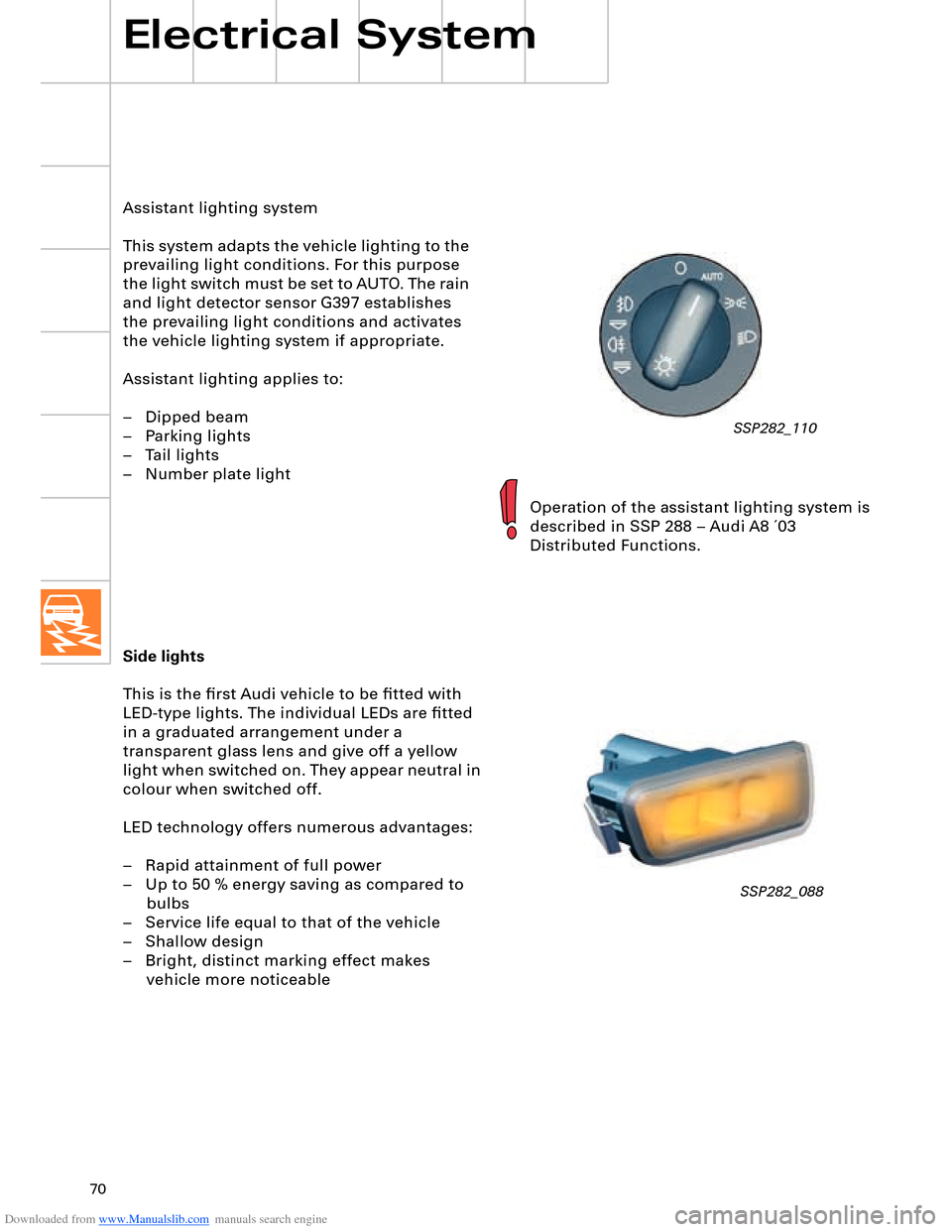
Downloaded from www.Manualslib.com manuals search engine 70
Electrical System
Side lights
This is the first Audi vehicle to be fitted with
LED-type lights. The individual LEDs are fitted
in a graduated arrangement under a
transparent glass lens and give off a yellow
light when switched on. They appear neutral in
colour when switched off.
LED technology offers numerous advantages:
– Rapid attainment of full power
– Up to 50 % energy saving as compared to
bulbs
– Service life equal to that of the vehicle
– Shallow design
– Bright, distinct marking effect makes
vehicle more noticeable
SSP282_088
Assistant lighting system
This system adapts the vehicle lighting to the
prevailing light conditions. For this purpose
the light switch must be set to AUTO. The rain
and light detector sensor G397 establishes
the prevailing light conditions and activates
the vehicle lighting system if appropriate.
Assistant lighting applies to:
– Dipped beam
– Parking lights
– Tail lights
– Number plate light
Operation of the assistant lighting system is
described in SSP 288 – Audi A8 ´03
Distributed Functions.
SSP282_110
Page 71 of 96
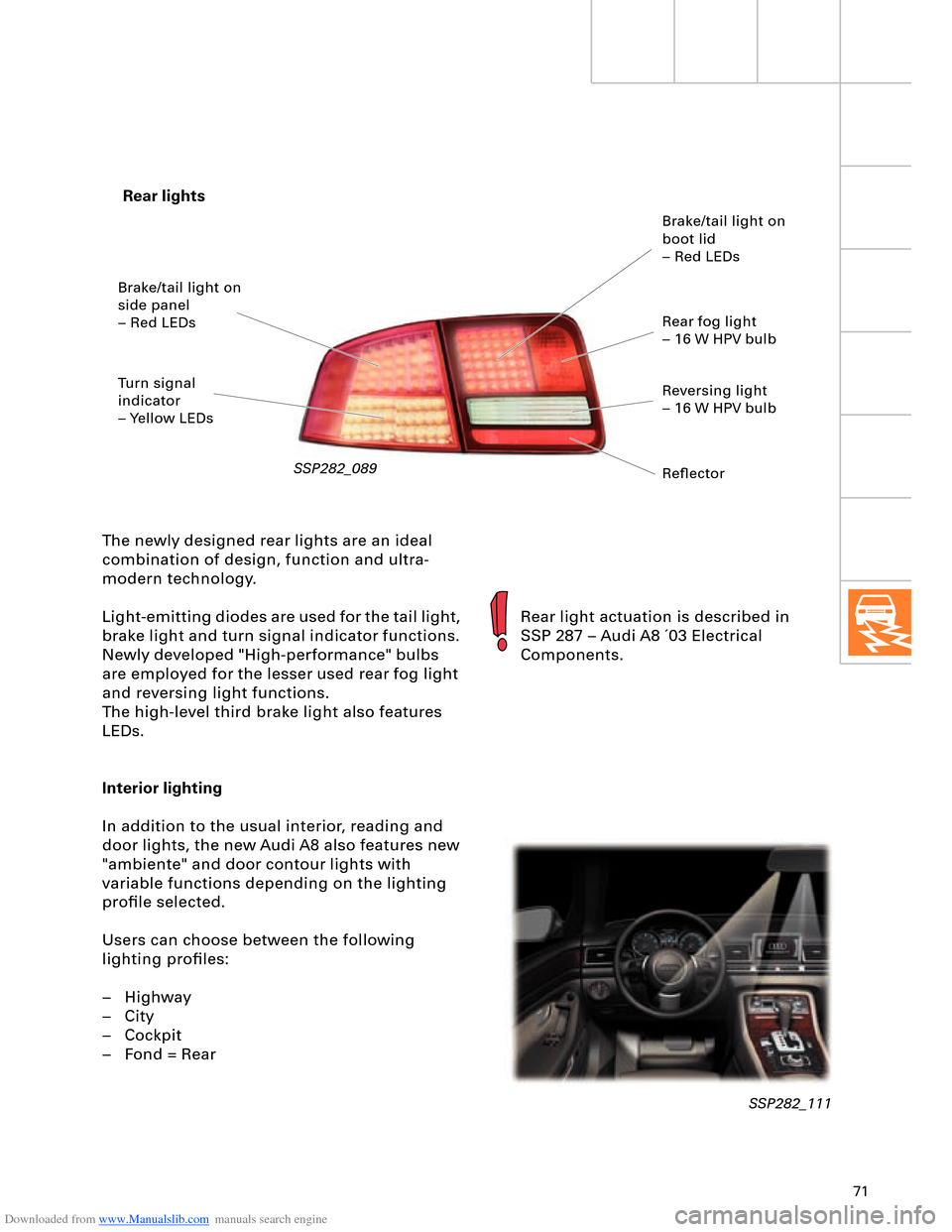
Downloaded from www.Manualslib.com manuals search engine 71
Rear lights
SSP282_089
The newly designed rear lights are an ideal
combination of design, function and ultra-
modern technology.
Light-emitting diodes are used for the tail light,
brake light and turn signal indicator functions.
Newly developed "High-performance" bulbs
are employed for the lesser used rear fog light
and reversing light functions.
The high-level third brake light also features
LEDs.
Interior lighting
In addition to the usual interior, reading and
door lights, the new Audi A8 also features new
"ambiente" and door contour lights with
variable functions depending on the lighting
profile selected.
Users can choose between the following
lighting profiles:
– Highway
– City
– Cockpit
– Fond = Rear
Rear light actuation is described in
SSP 287 – Audi A8 ´03 Electrical
Components.
SSP282_111
Brake/tail light on
side panel
– Red LEDs
Turn signal
indicator
– Yellow LEDsBrake/tail light on
boot lid
– Red LEDs
Rear fog light
– 16 W HPV bulb
Reversing light
– 16 W HPV bulb
Reflector
Page 72 of 96
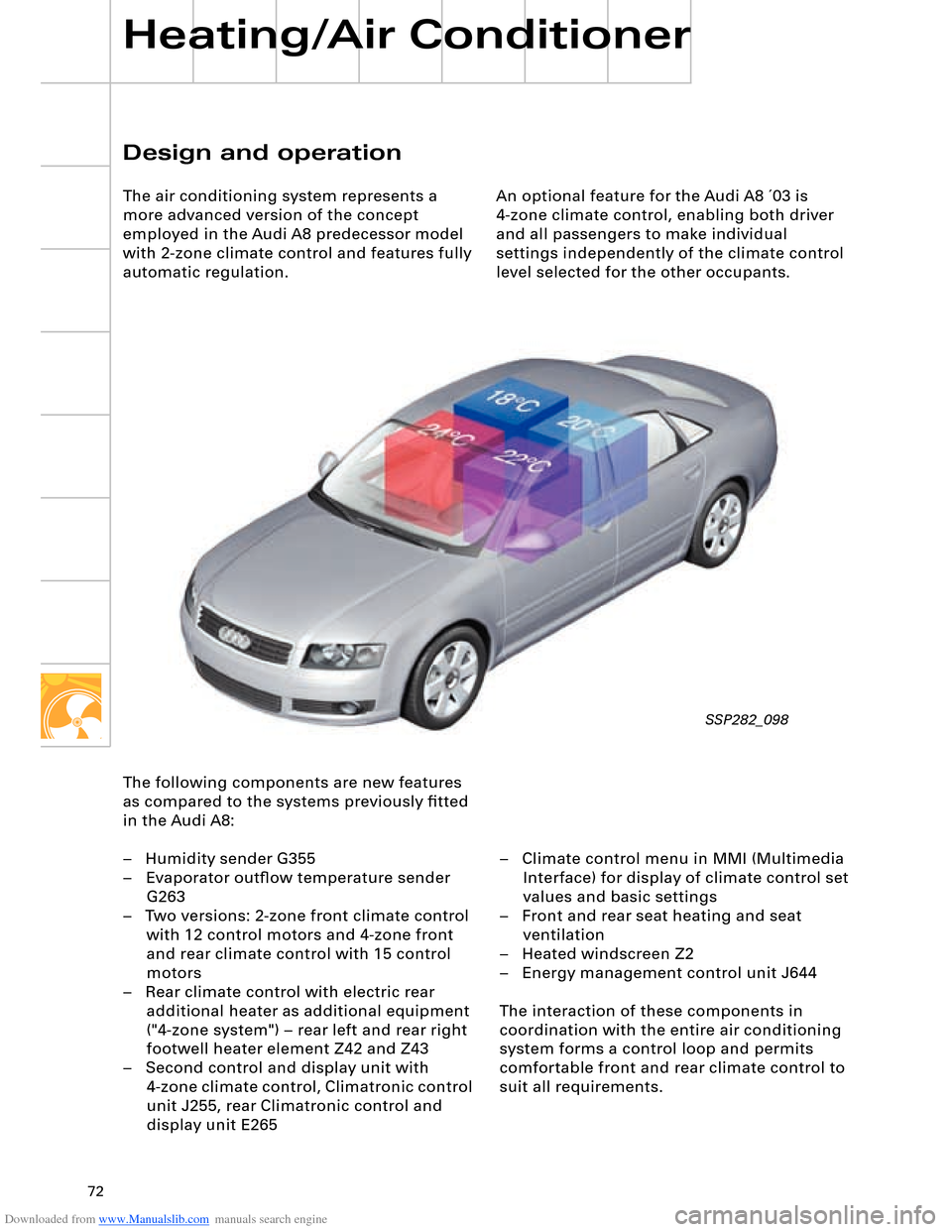
Downloaded from www.Manualslib.com manuals search engine 72
An optional feature for the Audi A8 ´03 is
4-zone climate control, enabling both driver
and all passengers to make individual
settings independently of the climate control
level selected for the other occupants.
Design and operation
The air conditioning system represents a
more advanced version of the concept
employed in the Audi A8 predecessor model
with 2-zone climate control and features fully
automatic regulation.
Heating/Air Conditioner
The following components are new features
as compared to the systems previously fitted
in the Audi A8:
– Humidity sender G355
– Evaporator outflow temperature sender
G263
– Two versions: 2-zone front climate control
with 12 control motors and 4-zone front
and rear climate control with 15 control
motors
– Rear climate control with electric rear
additional heater as additional equipment
("4-zone system") – rear left and rear right
footwell heater element Z42 and Z43
– Second control and display unit with
4-zone climate control, Climatronic control
unit J255, rear Climatronic control and
display unit E265– Climate control menu in MMI (Multimedia
Interface) for display of climate control set
values and basic settings
– Front and rear seat heating and seat
ventilation
– Heated windscreen Z2
– Energy management control unit J644
The interaction of these components in
coordination with the entire air conditioning
system forms a control loop and permits
comfortable front and rear climate control to
suit all requirements.
SSP282_098
Page 73 of 96

Downloaded from www.Manualslib.com manuals search engine 7374
A distinction is made between two air
conditioner unit versions
– 2-zone front and rear climate
control
– 4-zone front and rear climate
control
and three types of control and
display unit
– Air conditioner control panel with
no seat heating/ventilation
– Air conditioner control panel with
seat heating
– Air conditioner control panel with
seat heating and seat ventilation
(identified by part number index).
SSP282_099
Self-diagnosis
Fault diagnosis and measured value blocks
for air conditioner and seat heating system
can be read out by way of address words 08
"Air conditioner/heater electronics" and 28
"Rear climate control". The functions of and
exact procedure for self-diagnosis and
assisted fault-finding with VAS 5051 can be
found in the Heating/Air Conditioner
Workshop Manual for the relevant vehicle
model.
Operating principle
When the ignition is switched on, the
Climatronic control unit J255 starts up with
the same temperature, air distribution and
fresh-air blower speed settings etc. as were
applicable the last time the ignition was
switched off by way of the appropriate key or
using fingerprint recognition.
If fingerprint recognition has been
implemented, this has priority over key
recognition (refer also to SSP 287 – Audi A8 ´03
Electrical Components).
Personalised settings
The following settings can be made for each
climate control zone (front left, right and,
optionally, with 4-zone climate control rear left
and right):
– Left/right temperature
– Air flow
– Left/right air distribution
– Left/right seat heating
– Left/right seat ventilation
– Operating modes (AUTO for driver and front
passenger, temperature-adjustable centre
vents, automatically controlled
recirculated-air mode, ECON)
The heated windscreen can be activated by
way of the air conditioner defrost button or
the air conditioner control unit automatically
switches on the electric heated windscreen if
the appropriate conditions are satisfied
(windscreen defrost or automatic mode on
cold starting).
The Climatronic J255 and heated windscreen
J505 control units communicate by way of the
LIN bus. The Climatronic control unit transmits
the specified windscreen heating power to the
heated windscreen control unit on the LIN bus.
Heating/Air Conditioner
Key recognition takes place in the case of
remote control (radio or key transponder),
with the driver identification control unit
providing the Climatronic control unit J255
with the appropriate information by way of
the CAN bus.
The electrically heated windscreen is only
supplied with the amount of power which can
currently be drawn from the electrical system
without draining the battery. This is
monitored by the energy management
control unit J644.
As is the case with the Audi A4, the
windscreen is heated by applying voltage to a
metallic foil fitted in the glass (refer to
SSP 213).
As in the Audi A4, the air conditioner
compressor is regulated as a function of load
and controlled externally by way of the
compressor regulating valve (refer to
SSP 240). The Climatronic control unit J255 is
connected to the convenience CAN, via
which diagnosis is also performed.
A manual air conditioning system is not
available.
Page 75 of 96
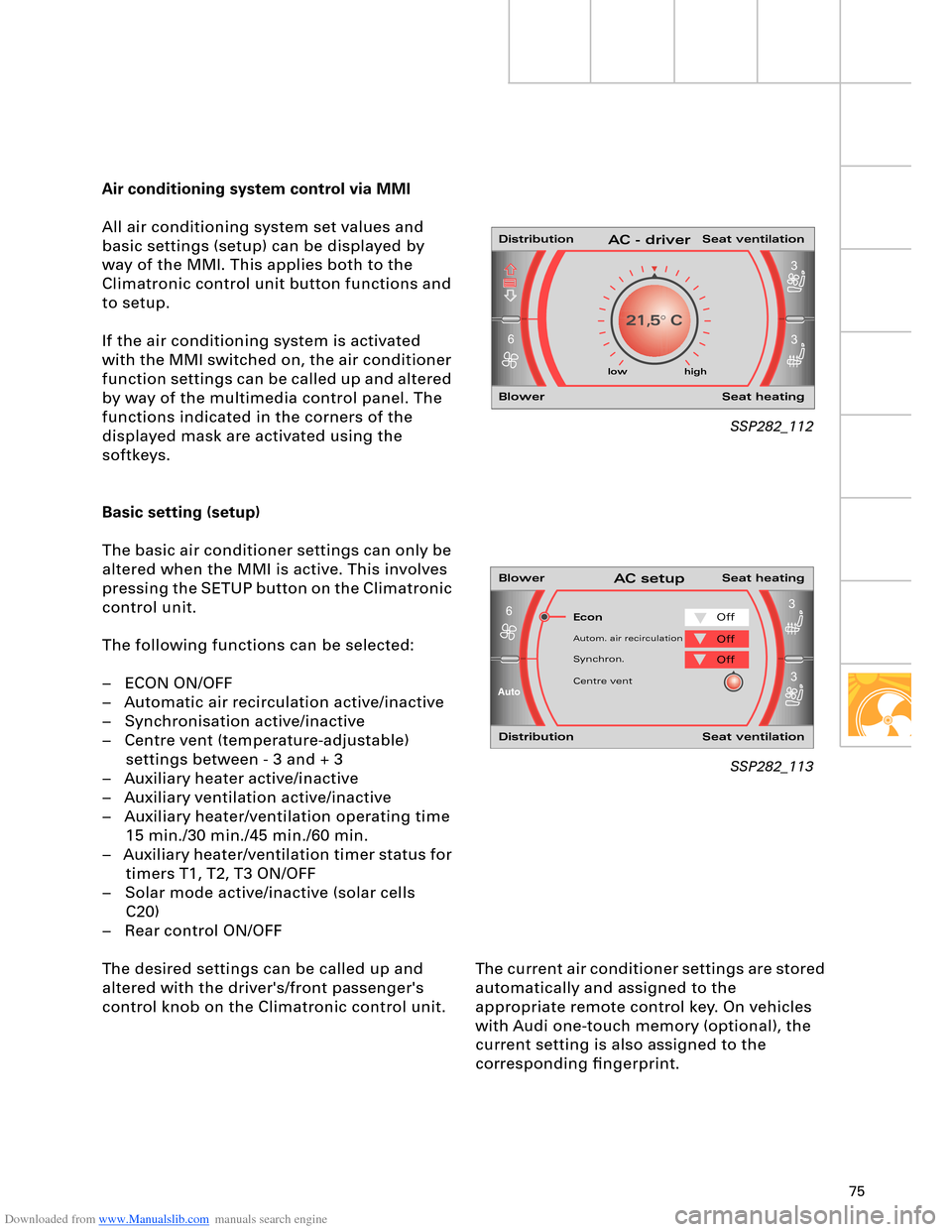
Downloaded from www.Manualslib.com manuals search engine 75
3
36
Auto
21,5° C
63
3
The current air conditioner settings are stored
automatically and assigned to the
appropriate remote control key. On vehicles
with Audi one-touch memory (optional), the
current setting is also assigned to the
corresponding fingerprint. Air conditioning system control via MMI
All air conditioning system set values and
basic settings (setup) can be displayed by
way of the MMI. This applies both to the
Climatronic control unit button functions and
to setup.
If the air conditioning system is activated
with the MMI switched on, the air conditioner
function settings can be called up and altered
by way of the multimedia control panel. The
functions indicated in the corners of the
displayed mask are activated using the
softkeys.
Basic setting (setup)
The basic air conditioner settings can only be
altered when the MMI is active. This involves
pressing the SETUP button on the Climatronic
control unit.
The following functions can be selected:
– ECON ON/OFF
– Automatic air recirculation active/inactive
– Synchronisation active/inactive
– Centre vent (temperature-adjustable)
settings between - 3 and + 3
– Auxiliary heater active/inactive
– Auxiliary ventilation active/inactive
– Auxiliary heater/ventilation operating time
15 min./30 min./45 min./60 min.
– Auxiliary heater/ventilation timer status for
timers T1, T2, T3 ON/OFF
– Solar mode active/inactive (solar cells
C20)
– Rear control ON/OFF
The desired settings can be called up and
altered with the driver's/front passenger's
control knob on the Climatronic control unit.
SSP282_112
SSP282_113
low high
Econ
Distribution Seat ventilation
Blower Seat heatingAC - driver
Blower Seat heatingAC setup
Distribution Seat ventilation
Off
Autom. air recirculationOff
Synchron.Off
Centre vent
Page 84 of 96
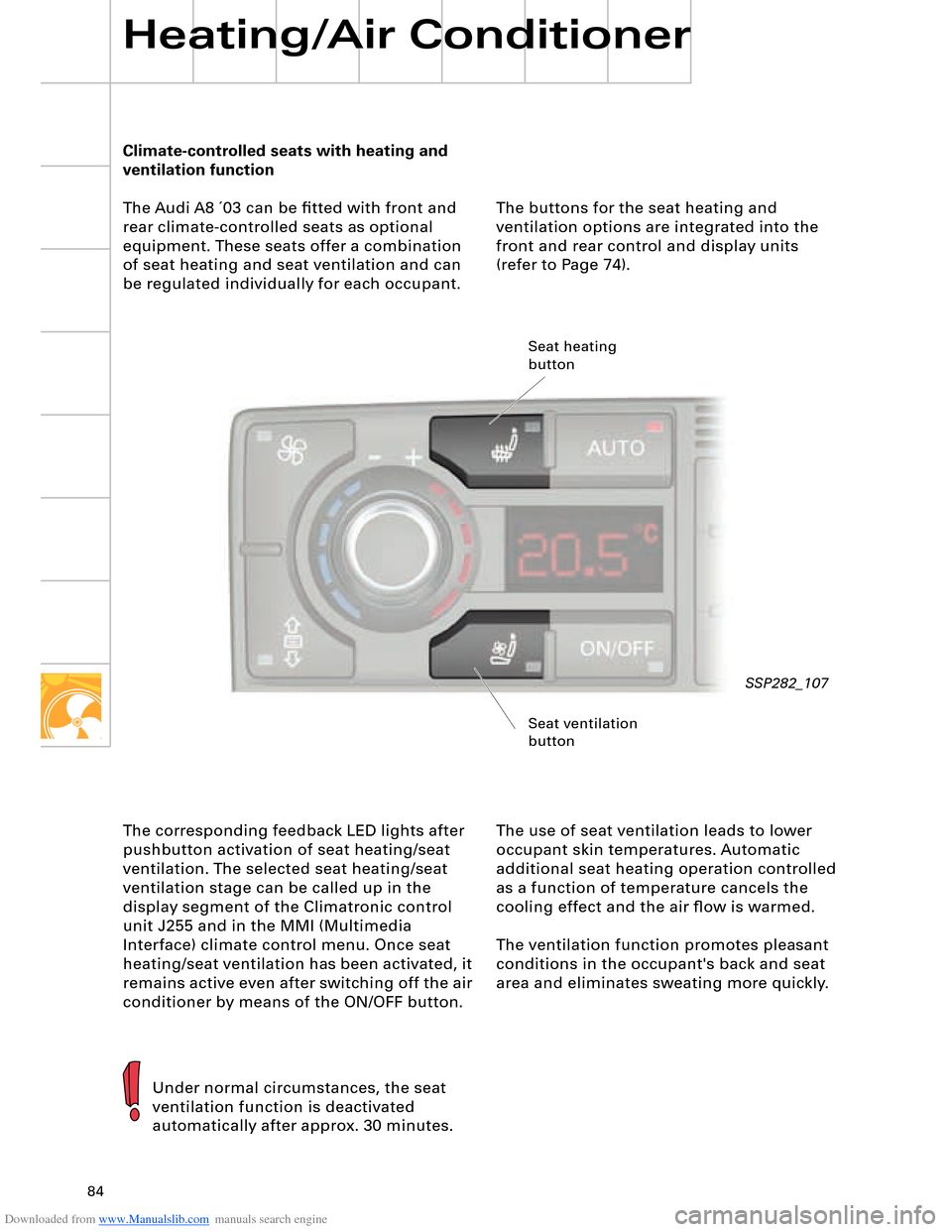
Downloaded from www.Manualslib.com manuals search engine 84
The buttons for the seat heating and
ventilation options are integrated into the
front and rear control and display units
(refer to Page 74). Climate-controlled seats with heating and
ventilation function
The Audi A8 ´03 can be fitted with front and
rear climate-controlled seats as optional
equipment. These seats offer a combination
of seat heating and seat ventilation and can
be regulated individually for each occupant.
Heating/Air Conditioner
The corresponding feedback LED lights after
pushbutton activation of seat heating/seat
ventilation. The selected seat heating/seat
ventilation stage can be called up in the
display segment of the Climatronic control
unit J255 and in the MMI (Multimedia
Interface) climate control menu. Once seat
heating/seat ventilation has been activated, it
remains active even after switching off the air
conditioner by means of the ON/OFF button.The use of seat ventilation leads to lower
occupant skin temperatures. Automatic
additional seat heating operation controlled
as a function of temperature cancels the
cooling effect and the air flow is warmed.
The ventilation function promotes pleasant
conditions in the occupant's back and seat
area and eliminates sweating more quickly.
Under normal circumstances, the seat
ventilation function is deactivated
automatically after approx. 30 minutes.
SSP282_107 Seat heating
button
Seat ventilation
button
Page 90 of 96
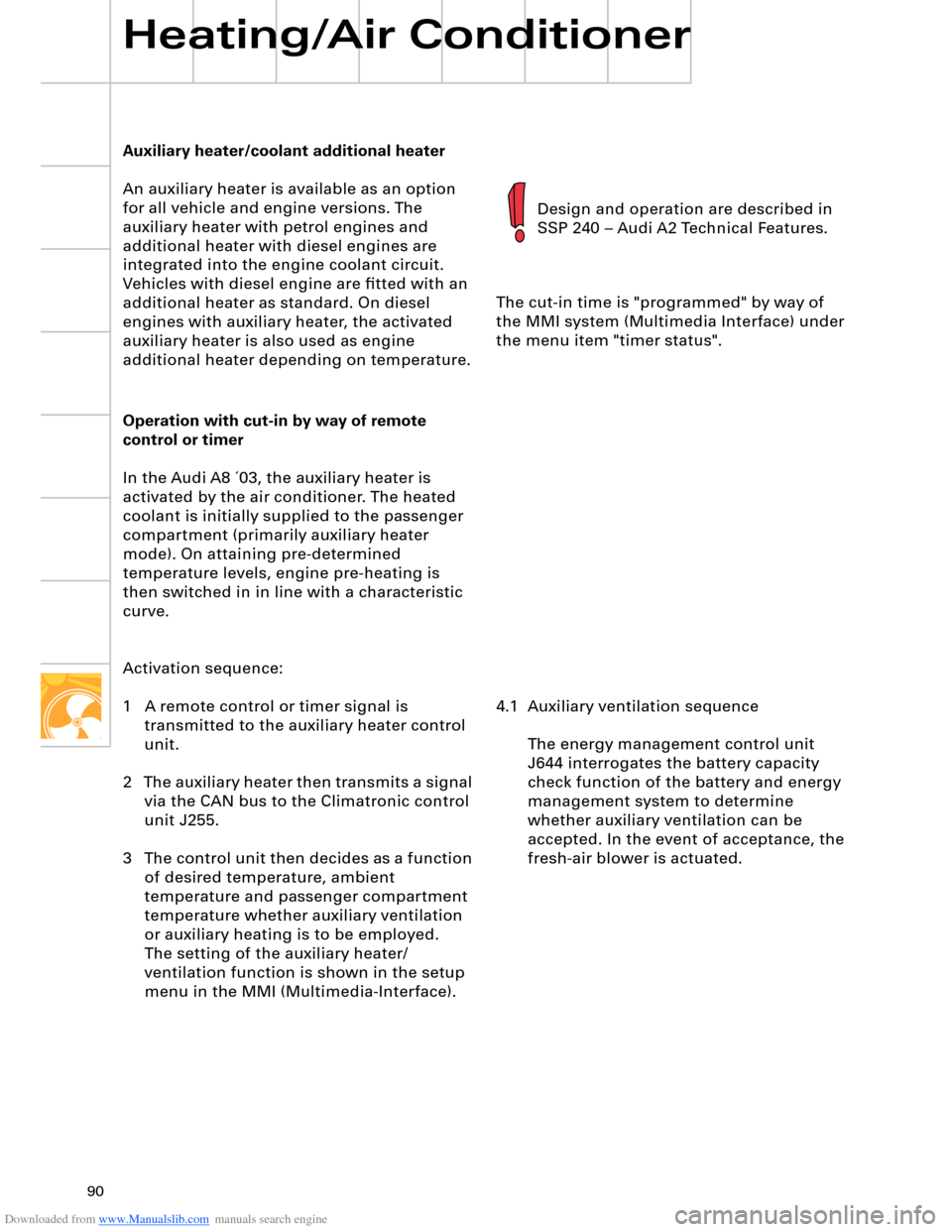
Downloaded from www.Manualslib.com manuals search engine 90
Auxiliary heater/coolant additional heater
An auxiliary heater is available as an option
for all vehicle and engine versions. The
auxiliary heater with petrol engines and
additional heater with diesel engines are
integrated into the engine coolant circuit.
Vehicles with diesel engine are fitted with an
additional heater as standard. On diesel
engines with auxiliary heater, the activated
auxiliary heater is also used as engine
additional heater depending on temperature.
Heating/Air Conditioner
Design and operation are described in
SSP 240 – Audi A2 Technical Features.
Operation with cut-in by way of remote
control or timer
In the Audi A8 ´03, the auxiliary heater is
activated by the air conditioner. The heated
coolant is initially supplied to the passenger
compartment (primarily auxiliary heater
mode). On attaining pre-determined
temperature levels, engine pre-heating is
then switched in in line with a characteristic
curve.
Activation sequence:
1 A remote control or timer signal is
transmitted to the auxiliary heater control
unit.
2 The auxiliary heater then transmits a signal
via the CAN bus to the Climatronic control
unit J255.
3 The control unit then decides as a function
of desired temperature, ambient
temperature and passenger compartment
temperature whether auxiliary ventilation
or auxiliary heating is to be employed.
The setting of the auxiliary heater/
ventilation function is shown in the setup
menu in the MMI (Multimedia-Interface).The cut-in time is "programmed" by way of
the MMI system (Multimedia Interface) under
the menu item "timer status".
4.1 Auxiliary ventilation sequence
The energy management control unit
J644 interrogates the battery capacity
check function of the battery and energy
management system to determine
whether auxiliary ventilation can be
accepted. In the event of acceptance, the
fresh-air blower is actuated.